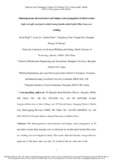JavaScript is disabled for your browser. Some features of this site may not work without it.
| dc.contributor.author | Feng, Jiecai | |
| dc.contributor.author | Li, Liqun | |
| dc.contributor.author | Chen, Yanbin | |
| dc.contributor.author | Tian, Yingzhong | |
| dc.contributor.author | Sun, Yongle | |
| dc.contributor.author | Zhang, Xuanjun | |
| dc.contributor.author | Zhang, Jie | |
| dc.date.accessioned | 2020-12-14T12:33:59Z | |
| dc.date.available | 2020-12-14T12:33:59Z | |
| dc.date.issued | 2020-10-13 | |
| dc.identifier.citation | Feng J, Li L, Chen Y, et al., (2021) Inhomogeneous microstructure and fatigue crack propagation of thick-section high strength steel joint welded using double-sided hybrid fiber laser-arc welding. Optics and Laser Technology, Volume 134, February 2021, Article number 106668 | en_UK |
| dc.identifier.issn | 0030-3992 | |
| dc.identifier.uri | https://doi.org/10.1016/j.optlastec.2020.106668 | |
| dc.identifier.uri | https://dspace.lib.cranfield.ac.uk/handle/1826/16089 | |
| dc.description.abstract | The inhomogeneous microstructure and fatigue crack propagation of 30 mm thick-section high strength steel welded joint by double-sided hybrid fiber laser-arc welding were investigated in detail. The results indicated that the average effective grain size of the laser zone was only 1/2 of that of the arc zone, due to the faster cooling rate of the laser resource. The base metal consisted of massive polygonal ferrites and small granular carbides, while fine grained region, the coarse grained region and weld metal were all composed of martensite with a high dislocation density. Compared with the arc zone, the percentage of grain boundaries with high misorientation angle increased 24% for the laser zone, as the average grain size of the laser zone was smaller than that of the arc zone. The results also revealed that the fatigue crack propagation resistance of the welded joint was higher than that of the base metal. Meanwhile, a significant increase in the fatigue crack propagation resistance of the laser zone occurred, as compared with the arc zone, due to the refined grains and the high proportion of the grain boundaries with high misorientation angle (>15°) in the laser zone. | en_UK |
| dc.language.iso | en | en_UK |
| dc.publisher | Elsevier | en_UK |
| dc.rights | Attribution-NonCommercial-NoDerivatives 4.0 International | * |
| dc.rights.uri | http://creativecommons.org/licenses/by-nc-nd/4.0/ | * |
| dc.subject | Welding | en_UK |
| dc.subject | Steel | en_UK |
| dc.subject | Microstructure | en_UK |
| dc.subject | Fatigue | en_UK |
| dc.subject | Fracture | en_UK |
| dc.title | Inhomogeneous microstructure and fatigue crack propagation of thick-section high strength steel joint welded using double-sided hybrid fiber laser-arc welding | en_UK |
| dc.type | Article | en_UK |
Files in this item
The following license files are associated with this item:
This item appears in the following Collection(s)
-
Staff publications (SATM) [4395]

